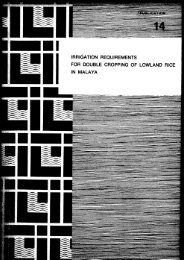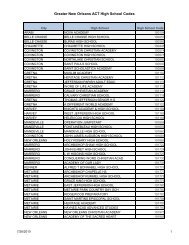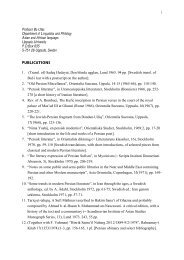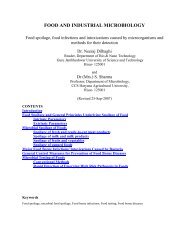On the Future of Indigenous Traditions - Munin
On the Future of Indigenous Traditions - Munin
On the Future of Indigenous Traditions - Munin
You also want an ePaper? Increase the reach of your titles
YUMPU automatically turns print PDFs into web optimized ePapers that Google loves.
forests <strong>of</strong> Saranda. Saranda is <strong>the</strong> largest Sal tree forest in Asia, forming a tropical<br />
forest in <strong>the</strong> south west <strong>of</strong> Jharkhand.<br />
The land formation <strong>of</strong> most <strong>of</strong> Jharkhand is a plateau, and <strong>the</strong> plains in <strong>the</strong> Damoder<br />
river valley on <strong>the</strong> central nor<strong>the</strong>ast <strong>of</strong> <strong>the</strong> region make it <strong>the</strong> most fertile land. Fur<strong>the</strong>r<br />
north is <strong>the</strong> river Ganges dividing most <strong>of</strong> Santhal Parganas <strong>of</strong> Jharkhand from Bihar.<br />
Jharkhand also has <strong>the</strong> richest mineral deposit <strong>of</strong> India which includes, coal, ores <strong>of</strong><br />
iron, copper, uranium, among o<strong>the</strong>rs are gold, limestone, asbestos and many o<strong>the</strong>rs.<br />
1.2.2. – Cultural<br />
Jharkhand’ culture has been predominately <strong>the</strong> Adivasi or aboriginal culture, both in<br />
its appearance and spirit as well. However, much <strong>of</strong> its social and cultural orientation<br />
has changed and its spirit is dying out due to <strong>the</strong> outside administrative system and its<br />
political discourse. The culture <strong>of</strong> <strong>the</strong> Adivasis in Jharkhand has been different from<br />
<strong>the</strong> more recent settlers whose ways <strong>of</strong> life and culture have made <strong>the</strong> Adivasi culture<br />
more invisible and in some cases stigmatized for <strong>the</strong> Adivasis. Initially <strong>the</strong> Adivasi<br />
culture was a rich culture, which has been a reflection <strong>of</strong> both <strong>the</strong>ir social and political<br />
life. Their music and songs based on five note tones (instead <strong>of</strong> seven 11 ) were said to<br />
be as if ‘walking is dancing and talking is singing’ based on <strong>the</strong> festivals at different<br />
seasons <strong>of</strong> <strong>the</strong> year.<br />
1.2.3. - Social<br />
Socially, <strong>the</strong> Adivasi communities here have been a more homogeneous group,<br />
coming from mainly two language groups, later joined by <strong>the</strong> third language group,<br />
<strong>the</strong> caste Hindu Aryan, and <strong>the</strong> Muslim groups, too. Thus <strong>the</strong> mainstream societies<br />
and <strong>the</strong> Adivasi communities in Jharkhand today are divided in different groups and<br />
placed in different economic categories and social disparities.<br />
11 The seven musical notes in western classic starting from do, ray, me, fa, so, la, te; and in Indian<br />
classical sa, re, ga, ma, pa, da, ne; In <strong>the</strong> Adivasi music only five notes are sued so that not only<br />
specialised singers could sing but all can sing.<br />
24

















